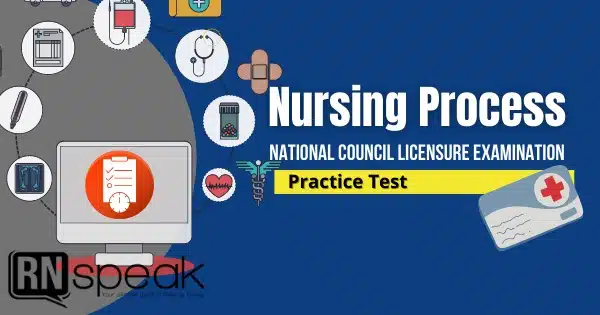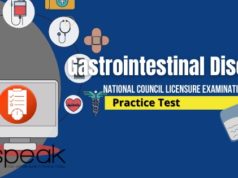
The nursing process functions as a systematic guide to client-centered care with five sequential steps. These are assessment, diagnosis, planning, implementation, and evaluation. The utilization of the nursing process to guide care is clinically significant going forward in this dynamic, complex world of client care. Nurses are in a position to promote change and impact client delivery care models in the future (Toney, 2022).
Read and analyze each question carefully and choose the best answer/s from the choices provided. At the end of these practice tests, correct answers and explanations are given.
Nursing Process NCLEX-RN Practice Questions
1. The nurse assesses a client who presents with abdominal pain. Which initial action by the nurse is correct?
A. Assess the symptomatic quadrant first.
B. Assess any quadrant initially.
C. Assess the symptomatic quadrant last.
D. Assess the first or second quadrant initially.
2. The nurse is caring for a postoperative client and is documenting assessment findings. Which assessment finding must be included as subjective data?
A. Verbalizations of pain
B. ECG results
C. Blood pressure
D. Diagnostic test results
3. The nurse is caring for a foreign client after an emergency gallbladder surgery. The client speaks a few English words and has no family members. During discharge teaching, which action by the nurse will best promote an effective understanding of wound care instructions?
A. Ask for an interpreter to be present during the discharge teaching.
B. Demonstrate the procedure and let the client perform a re-demonstration.
C. Provide written instructions for the client to bring home and read.
D. Ask if the client understands frequently during the demonstration.
4. A client is receiving discharge medication teaching from the nurse. Which human element affects the client’s understanding the most regarding medication administration?
A. The client’s cognitive abilities
B. The client’s socioeconomic status
C. The client’s occupational hazards
D. The client’s response to recovery
5. The nurse assesses a client who underwent a total abdominal hysterectomy. Which early assessment finding indicates the development of shock?
A. Urine output of 30 ml/hour
B. Restlessness
C. Hypotension
D. Tachycardia
6. The nurse is caring for an unconscious client who requires an initial assessment. Which pulse must be palpated?
A. Femoral
B. Radial
C. Carotid
D. Brachial
7. In the Medical-Surgical unit, the nurse cares for multiple clients. Which action by the nurse is an example of primary prevention?
A. Providing occupational therapy to a client with arthritis.
B. Administering digoxin to a client with heart failure.
C. Obtaining a Papanicolau smear for a lenient with cervical cancer.
D. Administering a BCG vaccine to a newborn.
8. The nurse assesses a client’s abdomen. Which action by the nurse is best?
A. Palpates the abdomen initially.
B. Inspects the client’s abdomen first.
C. Performs percussion of the abdomen first.
D. Auscultates bowel sounds first.
9. The nurse uses the nursing process to identify a client’s responses to actual or potential health concerns. Which step of the nursing process will the nurse utilize?
A. Nursing diagnosis
B. Nursing assessment
C. Nursing evaluation
D. Nursing implementation
10. The nurse is formulating a plan of care for a client diagnosed with deep vein thrombosis. Which nursing diagnosis is the nurse’s priority?
A. Excess fluid volume related to increased venous constriction
B. Risk for injury related to generalized edema
C. Ineffective peripheral tissue perfusion related to venous congestion
D. Impaired gas exchange related to increased blood circulation
11. A client’s care plan is being revised by the nurse. Which part of the care plan does the revision occur?
A. Diagnosis
B. Implementation
C. Planning
D. Evaluation
12. The nurse has administered the client’s prescribed medications and returns to the nurse’s station. Which aspect of implementation will the nurse perform next?
A. Establishing desired outcomes
B. Documentation of the medications given
C. Creating realistic goals
D. Developing the outline of the content
13. The nurse is planning for the care of a client diagnosed with diabetes mellitus. The client reports experiencing impotency and states worrying about its effect on the client’s marriage. Which action by the nurse is best?
A. Provide the client and spouse privacy to discuss the concerns.
B. Answer all of the client’s questions honestly and without prejudice.
C. Refer the client to a healthcare professional licensed for sex counseling.
D. Provide emotional support to the client and spouse.
14. The nurse is caring for a postoperative client who underwent general anesthesia from a major abdominal surgery. Which nursing diagnosis is the nurse’s priority?
A. Risk for aspiration related to administration of general anesthesia
B. Acute pain related to surgical incisions
C. Deficient fluid volume related to increased blood loss
D. Impaired physical mobility related to pain caused by surgery
15. A client is brought to the Emergency Department with blunt chest trauma due to a vehicular accident. Which action is the nurse’s priority
A. Splinting the chest with a pillow
B. Assessing the client’s airway
C. Providing pain medications
D. Calling the client’s next of kin
16. A client’s laboratory results show a hemoglobin level of 14 g/dL; a white blood cell (WBC) count of 1000/µL; and a hematocrit level of 40%. Which client goal is the nurse’s priority?
A. Restoring fluid balance
B. Promoting rest
C. Preventing infection
D. Preventing an injury
17. The nurse is creating a client’s plan of care and uses critical thinking and the nursing process. Which element is common for critical thinking and the nursing process?
A. Both use a systematic series of steps.
B. Both are specifically client-centered processes.
C. Both were developed solely for nursing practice.
D. Both are essential to use in nursing practice.
18. The nurse analyzes a client’s data and identifies client problems during care planning. At which step of the nursing process do these actions occur?
A. Implementation
B. Diagnosis
C. Assessment
D. Evaluation
19. When creating a care plan for a client, the nurse utilizes the nursing process. At which phase does the nurse decide that the actions performed had a positive effect on the client’s condition?
A. Evaluation
B. Planning
C. Diagnosis
D. Implementation
20. The nurse uses critical thinking skills and critical thinking attitudes when caring for a client. Which similarities do both have?
A. Both are like feelings rather than cognitive activities.
B. Both are applicable to all aspects of a client’s life.
C. Both influence the nurse’s problem-solving and decision-making.
D. Both can be used interchangeably with each other.
21. The nurse finishes assessing a client in the Emergency Department. Which assessment findings need to be validated?
A. The chest x-ray result indicates pneumonia in the right lower lobe.
B. The client’s respiratory rate is 17/minute with clear breath sounds.
C. The urinalysis result shows white blood cells in the urine.
D. The client reports being feverish; axillary temperature is at 98℉.
22. The nurse plans to identify a nursing diagnosis for a client. Which organized form of assessment is best for data collection? Select all that apply.
A. A head-to-toe assessment
B. Maslow’s Hierarchy of Needs
C. Gordon’s Functional Health Patterns
D. A body systems model
E. The Adaptation Model of Nursing
23. The nurse prepares to assess a client in the Emergency Department. Which sequence of nursing actions is recommended when examining the client, excluding the abdominal assessment?
A. Auscultation, inspection percussion, palpation
B. Palpation, percussion, inspection, auscultation
C. Inspection, palpation, percussion, auscultation
D. Inspection, auscultation, percussion, palpation
24. The nurse assesses a school-aged client. Which nursing action is best performed specifically for the shool-aged client?
A. Show how the equipment works first before using it.
B. Ask the parents to leave before the procedure.
C. Let the client help during the assessment.
D. Perform invasive procedures last.
25. The nurse is caring for a morbidly obese client. Which nursing intervention decreases pressure from the client’s skin folds?
A. Keeping the linens wrinkle-free
B. Covering the mattress with sheepskin
C. Applying petrolatum barrier between skin folds
D. Separating the skin folds with clean towels
26. After a shift, the nurse remembers not documenting a dressing change performed for a client. Which action by the nurse is next?
A. Document it as a late entry in the client’s chart.
B. Fill out an occurrence report before signing out.
C. Let the next nurse document the procedure.
D. Insert the information into the earlier notes.
27. The nurse is assessing a client diagnosed with urinary incontinence. Which assessment finding does the nurse anticipate finding?
A. Fluid intake of less than 1,500 ml daily
B. Perineal skin irritation
C. History of antihistamine intake
D. Increase in dietary salt intake
28. The nurse is caring for a client with a condom catheter. Which nursing action for the client is correct?
A. Change the condom catheter every 8 hours.
B. Assess the penis for circulation after 15 minutes.
C. Anchor the collecting tube to the lower abdomen.
D. Ensure that the condom fits the tip of the penis tightly.
29. During handover, the nurse receives information that a client assignment is experiencing incontinence with a sense of an urge to void. Which nursing diagnosis is best for the client?
A. Urge urinary incontinence
B. Stress urinary incontinence
C. Functional urinary incontinence
D. Overflow urinary incontinence
30. The nurse evaluates a client with bladder incontinence. Which behavior indicates that bladder training is effective?
A. The client drinks citrus juices frequently.
B. The client voids each time there is an urge.
C. The client performs pelvic muscle exercises.
D. The client keeps a stash of adult diapers.







![Saudi Council Exam for Nurses [ Set 1] saudi council exam for nurses](https://rnspeak.com/wp-content/uploads/2021/08/saudi-council-exam-for-nurses-238x178.jpg)